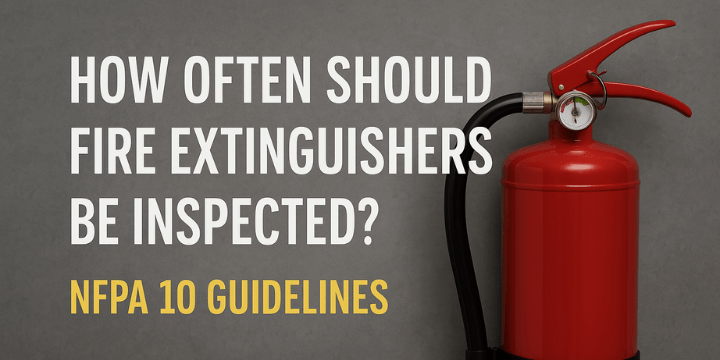Fire extinguishers are vital in our defense against small fires, and ensuring they are always in working order is crucial. Regular inspection, testing, and maintenance (ITM) protocols are essential for reliable and effective fire extinguisher services performance. This article will delve into the requirements outlined in NFPA 10, the Standard on the Installation of Portable Fire Extinguishers, which provides guidelines to ensure your extinguisher is ready for fire protection.
How Often Should Fire Extinguishers Be Inspected? NFPA 10 Guidelines

Visual Inspections: A Simple Yet Crucial Step
Visual inspections can be conducted by any knowledgeable and competent person; certification is not required.
Frequency: NFPA 10 recommends monthly inspections after the initial installation. However, more frequent inspections may be necessary for extinguishers in environments prone to rust, impact, or tampering.
Recordkeeping: Records of monthly fire extinguisher inspections should be maintained either by using inspection tags or labels on the extinguisher or by documenting the inspections on paper or electronically.
The following information should be recorded:
- Month and year the inspection was performed
- Name of the person conducting the inspection
Fire Extinguisher Maintenance Procedures
Fire extinguisher maintenance ensures the extinguisher’s essential components are in working order. According to NFPA 10, the maintenance and inspection procedures should follow the manufacturer’s service manual, along with a thorough examination of key components, such as:
- Mechanical parts (e.g., the handle and trigger)
- Presence and condition of the extinguishing agent
- Expelling means (e.g., nozzle, hose)
- Physical condition (e.g., dents, rust, corrosion)
Who Should Perform Maintenance?
Maintenance should only be performed by a certified individual who is familiar with NFPA 10 guidelines. Certification requires specific knowledge and may involve testing accepted by the Authority Having Jurisdiction (AHJ).
- Frequency of Maintenance: NFPA 10 recommends performing external annual maintenance inspections during hydrostatic testing, or when discrepancies arise during visual inspections. Internal inspections are typically needed every 1 to 6 years, depending on the type of fire extinguisher. You can refer to NFPA 10 Table 7.3.3.1 for specific requirements based on the extinguisher type.
- Recordkeeping: Each extinguisher should have a tag or label indicating the maintenance has been performed. The label should include:
- Month and year of maintenance
- Name of the individual who performed the work
- Name of the servicing agency
Hydrostatic Testing: What You Need to Know
Hydrostatic testing is an important procedure for ensuring the structural integrity of your fire extinguisher. The process involves inspecting the internal and external condition of the extinguisher, then filling it with water at a specific pressure for a set duration. Afterward, the extinguisher is dried, reassembled, and recharged.
- Failure Criteria: If any leakage, distortion, or movement of couplings occurs during the test, the extinguisher fails and must be condemned.
Who Can Perform Hydrostatic Testing?
Hydrostatic testing should only be performed by trained and certified professionals. This process requires specialized equipment and expertise, as it can be dangerous if done incorrectly.
- Frequency of Hydrostatic Testing: Testing intervals typically vary between 5 and 12 years, depending on the extinguisher type. You can refer to NFPA 10 Table 8.3.1 for the specific requirements based on the type of extinguisher.
- Recordkeeping: A label should be affixed to the extinguisher for low-pressure cylinders, detailing the following:
- Name of the tester
- Date of the test
- Pressure at which the test was conducted
For high-pressure cylinders, the tester’s identification number and test date should be stamped on the extinguisher’s shoulder, top, head, neck, or foot ring.
Conclusion
This guide provides an overview of how fire extinguishers should be inspected, tested, and maintained (ITM) based on NFPA 10 guidelines. While it covers essential procedures, there are additional specifics and variations based on the type of extinguisher you have. For more detailed guidance or specific recommendations, it’s always a good idea to consult with certified professionals.
Remember, regular inspections, maintenance, and hydrostatic testing are critical to ensuring that your fire extinguishers are ready for use when you need them most. Stay safe and stay compliant!
Also Read:
Demystifying Fire Safety: Can Fire Extinguishers Explode?
